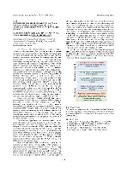Exploring the molecular mechanisms used by human BK polyomavirus to activate immune responses in "reservoir cells"

Autor
Datum vydání
2023Publikováno v
Czech Chemical Society Symposium SeriesRočník / Číslo vydání
21 (5)ISBN / ISSN
ISSN: 2336-7202Metadata
Zobrazit celý záznamKolekce
Abstrakt
At present, the Polyomaviridae family contains 14 human polyomaviruses (PyVs), among the most important are Merkel cell polyomavirus (MCPyV), the etiological agent of 80% of Merkel cell carcinomas, JCPyV and BKPyV causing progressive multifocal leukoencephalopathy and nephropathy, respectively, in immunocompromised individuals. Primary infection by polyomaviruses occurs in early childhood and is usually asymptomatic.1,2 After initial primary infection and dissemination, PVs persist in the organism by a not wellknown mechanism. In fact, it has been suggested that innate immune responses in the reservoir cells may contribute to PyV persistence.3,4 Although two cellular models have emerged recently to study the mechanism of BKPyV infection, there are still many gaps in the understanding of these models. One of the models is human microvascular endothelial cells (HMEVC) from the bladder (bd) or lung, which respond to BKPyV by producing interferon (IFN), and the other is renal proximal tubular epithelial cells (RPTEC), which do not respond immunologically to the virus. Cells that respond to BKPyV with production of IFN have been postulated as reservoirs of the BKPyV. In our group, a part of our research focuses on understanding the mechanisms of innate immune response activation and modulation in response to BKPyV infection.
Klíčová slova
Polyomavirus, BKPyV, cGAS-STING, HMVECs
Trvalý odkaz
https://hdl.handle.net/20.500.14178/2057Licence
Licence pro užití plného textu výsledku: Creative Commons Uveďte původ 4.0 International




